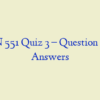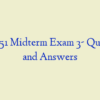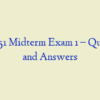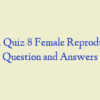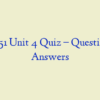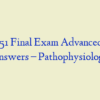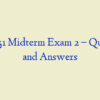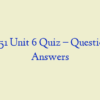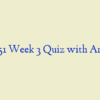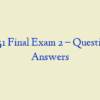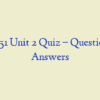Description
MN 551 Unit 7 Quiz – Pathophysiology across the Life Span
- A 4-year-old boy has had otitis media with effusion (OME) for several weeks and his condition has recently progressed to acute otitis media (AOM). Which of the following factors could have contributed to his AOM?
- Which of the following statements best captures the role of the adrenal cortex in maintaining homeostasis?
- A 29-year-old woman has been diagnosed with otosclerosis after several years of progressive hearing loss. What pathophysiologic process has characterized her diagnosis?
- A three-year-old girl has just been diagnosed with type 1A diabetes and her parents are currently receiving education from the diabetes education nurse at the hospital where their daughter is receiving treatment. How can the nurse best explain the etiology of their daughter’s health problem to her parents?
- An endocrinologist is providing care for a 30-year-old male who has lived with the effects of increased levels of GH. Which of the following teaching points about the patient’s future health risks is most accurate?
- Following a long history of fatigue, weakness, and poor appetite, a 39-year-old male has been diagnosed with hypopituitarism. Which of the following clinical findings would most likely cause his care team to suspect that the man has an additional endocrine disorder from a different source?
- Which of the following questions is most likely to be clinically useful in the differential diagnosis of sensorineural versus conductive hearing loss?
- As part of the diagnostic workup for a patient’s long-standing vertigo, a clinician wants to gauge the patient’s eye movements. Which of the following tests is the clinician most likely to utilize?
- A 51-year-old woman has been experiencing signs and symptoms of perimenopause and has sought help from her nurse practitioner. Doctors have confirmed a deficiency in estrogen levels as a contributing factor. Which of the following phenomena could potentially underlie the woman’s health problem?
- A woman with a diagnosis of type 2 diabetes has been ordered by her primary care provider to have a hemoglobin A1C test for the first time. The woman states, “I don’t see why you want to test my blood cells when it’s sugar that’s the problem.” What aspect of physiology will underlie the care provider’s response to the patient?
- A 46-year-old male has presented to the emergency department because of the eye pain, severe headache, and blurred vision that have followed an eye exam at an optometrist’s office earlier in the day. The patient tells the triage nurse that he received eyedrops during the exam “to keep my pupils wide open.” What differential diagnosis will the care team first suspect?.
- A 28-year-old male who is 6 feet 11 inches tall has a diagnosis of acromegaly. The man is explaining to a curious but sympathetic coworker exactly what accounts for his extraordinary height. Which of the following explanations demonstrates a sound understanding of his health problem?
- A stroke affecting which of the following areas of the brain would be most likely to leave an individual’s vestibular system intact and posture and balance maintained?
- Which of the following statements best captures an aspect of the role of hormones in the body?
- A 60-year-old man has presented to his nurse practitioner because of an earache that has become progressively more painful in recent days. After giving his history and having an examination with an otoscope, the man has been diagnosed with otitis externa. Which of the nurse practitioner’s following statements to the man is most accurate?
- A 30-year-old man with a diagnosis of type 1 diabetes is aware of the multiple effects that insulin has on his metabolism. Which of the following physiological processes are actions of insulin?
- During descent, an airplane passenger is complaining that his “ears are plugged.” What aspect of the structure and function of the ear best accounts for the passenger’s complaint? mn 551 unit 7 quiz
- Following a long history of faTgue, weakness, and poor appeTte, a 39-year-old male has been diagnosed with hypopituitarism. Which of the following clinical Fndings would most likely cause his care team to suspect that the man has an addiTonal endocrine disorder from a diµerent source?
- Which of the following best describes the half-life of a highly protein-bound drug such as thyroxine (99% protein bound)? ²he half-life would be
- A 21-year-old female is suspected of having inadequate funcTon of her hypothalamic –pituitary–thyroid system. Her care provider is planning to inject thyrotropin-releasing hormone (TRH) and then measure her levels of TSH. Which of the following diagnostic tests is being performed?
- Following the identification of low blood levels ofcorTisol and low 24-hour urinary free corTsol, a 51-year-old female client has been diagnosed with a primary adrenal corTtcal insufficiency. Which of the following health consequences would be a³ributable to her low levels ofcorTsol?
- A medical student is scheduled to undergo a clinical exam of his assessment skills under the supervision of the a³ending physician. As a result of this stressor, the student has high serum levels ofglucocorTcoid hormones such as corTsol. Which of the following statements best captures an aspect of the role o± glucocorTcoid hormones such as corTsol in the physiological response to stress?
- Following a meal, a woman’s blood glucose level has increased. In addition, her pancreas has increased the amount of insulin produced and released. Which of the following phenomena has occurred?
- Since steroid hormones are bound to protein carriers for transport, this means:
- Which of the following statements best captures an aspect of the ±uncTon of the hypothalamic –pituitary– adrenal (HPA) system?
- A patient with a new diagnosis of an endocrine disorder is unclear about how the body can control the levels of different hormones over time. Which of the following statements most accurately underlies the dominant regulation process of hormone levels in the body?
- Most hormone levels are controlled by way of a negative feedback cycle, in which low levels stimulate production and/or release. A positive feedback cycle would not achieve this effect. While some hormones are released on a diurnal schedule, the dominant form of hormone regulation in the body is that of negative feedback. Hormone release is not predetermined by the pituitary gland.
- A 21-year-old female is suspected of having inadequate function of her hypothalamic–pituitary–thyroid system. Her care provider is planning to inject thyrotropin-releasing hormone (TRH) and then measure her levels of TSH. Which of the following diagnostic tests is being performed?
- Following a meal, a woman’s blood glucose level has increased. In addition, her pancreas has increased the amount of insulin produced and released. Which of the following phenomena has occurred?
- Which of the following statements best captures the relationship between the hypothalamus and the pituitary gland as it relates to endocrine function? mn 551 unit 7 quiz
- An endocrinologist is providing care for a 30-year-old male who has lived with the effects of increased levels of growth hormone (GH). Which of the following teaching points about the client’s future health risks is most accurate?
MN 551 Unit 7 Quiz – Set 2
- A three-year-old girl has just been diagnose with type 1A diabetes. And her parents are currently receiving education from the diabetes education nurse at the hospital where their daughter is receiving treatment. How can the nurse best explain the etiology of their daughter’s health problem to her parents?
- A 60-year-old man has present to his nurse practitioner. Because of an earache that has become progressively more painful in recent days. After giving his history and having an examination with an otoscope, the man has been diagnosed with otitis externa. Which of the nurse practitioner’s following statements to the man is most accurate?
- A patient with a new diagnosis of an endocrine disorder is unclear about how the body can control the levels of different hormones over time. Which of the following statements most accurately underlies the dominant regulation process of hormone levels in the body?
- What does a high level of thyroid-stimulating hormone indicate?
- Following the identification of low levels of T3 and T4 coupled with the presence of a goiter, a 28-year-old female has been diagnosed with Hashimoto thyroiditis. In light of this diagnosis, which of the following assessment results would constitute an unexpected finding?
- A stroke affecting which of the following areas of the brain would be most likely to leave an individual’s vestibular system intact and posture and balance maintained?
- A care aide at a long-term care facility has ….a resident’s nurse practitioner that the 80-year-old woman’s eyes appear to be ….and her eyelids are …with sticky secretions. The woman subsequently has been diagnose with posterior blepharitis. Which of the following treatments is the nurse practitioner likely to initiate?
- An endocrinologist is providing care for a 30-year-old male who has lived with the effects of increased levels of GH. Which of the following teaching points about the patient’s future health risks is most accurate?
- A 46-year-old male has presented to the emergency department because of the eye pain, severe headache, and blurred vision that have followed an eye exam at an optometrist’s office earlier in the day. The patient tells the triage nurse that he received eyedrops during the exam “to keep my pupils wide open.” What differential diagnosis will the care team first suspect? mn 551 unti 7
- A patient with a history of an endocrine disorder exhibits signs and symptoms of hormone deficiency. Which of the following processes would the patient’s care team most likely rule out first as a contributing factor?
- A 51-year-old woman has been experiencing signs and symptoms of perimenopause and has sought help from her nurse practitioner. Doctors have confirmed a deficiency in estrogen levels as a contributing factor. Which of the following phenomena could potentially underlie the woman’s health problem?
- Which of the following hormones are derivatives of cholesterol?
- A 32-year-old man is complaining of burning, itching, photophobia. And severe pain in his right eye after swimming in the ocean. To determine that the eye condition is corneal rather than a conjunctival disease. Which of the following would be the distinguishing symptom?
- As part of the diagnostic workup for a patient’s long-standing vertigo, a clinician wants to gauge the patient’s eye movements. Which of the following tests is the clinician most likely to utilize?
- A woman with a diagnosis of type 2 diabetes has been ….by her primary care provider to have a hemoglobin A1C test for the first time. The woman states, “I don’t see why you want to test my blood cells when it’s sugar that’s the problem.” What aspect of physiology will underlie the care provider’s response to the patient?
- A patient with a new diagnosis of an endocrine disorder is unclear. About how the body can control the levels of different hormones over time. Which of the following statements most accurately underlies the dominant regulation process of hormone levels in the body?
- Large amounts of glucagon were recently ….into an individual’s circulation, but glucagon circulation has now ceased. Which of the following situations could have …to this inhibition of glucagon release? mn 551 unit 7 quiz
- Following a long history of fatigue, weakness, and poor appetite, a 39-year-old male has been diagnosed with hypopituitarism. Which of the following clinical findings would most likely cause his care team to suspect that the man has an additional endocrine disorder from a different source?
- A 21-year-old female is suspect of having inadequate function of her hypothalamic-pituitary-thyroid system. Her care provider is planning to inject thyrotropin-releasing hormone (TRH) and then measure her levels of TSH. Which of the following diagnostic tests is being perform?
- Which of the following hormones are derivatives of cholesterol?
- An endocrinologist is providing care for a 30-year-old male who has lived with the effects of increased levels of GH. Which of the following teaching points about the patient’s future health risks is most accurate?
- Which of the following statements best captures an aspect of the role of hormones in the body?
- A three-year-old girl has been diagnose with amblyopia. Which of the following pathophysiologic processes is most likely to underlie her health problem?
- A 60-year-old man has presented to his nurse practitioner because of an earache that has become progressively more painful in recent days. After giving his history and having an examination with an otoscope, the man has been diagnosed with otitis externa. Which of the nurse practitioner’s following statements to the man is most accurate ?
- Which of the following statements best describes an aspect of the normal process of glucose metabolism? mn 551 unit 7 quiz
- A 45 yo woman with a diagnosis of shingles is experiencing an acute onset of severe neuropathic pain. Which state of Selye’s characterization of stress response is the woman most likely experiencing at the moment?
- A 30 yo woman has sought care because of her recurrent photophobia, tearingand eye irritation. During assessment, her care provider asks about any history of cold sores or genital herpes. What is the rationale for the care provider’s line of questioning?
- Which of the following statements best captures the role of the adrenal cortex in maintaining homeostasis?
![]()

